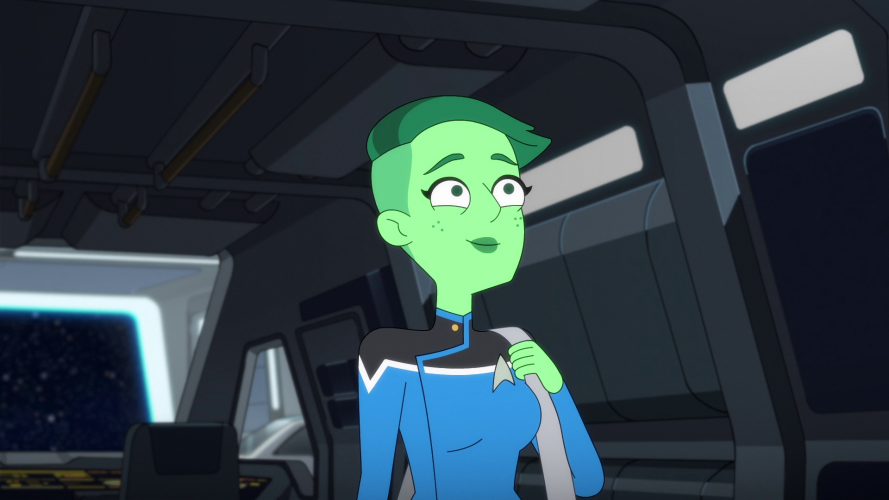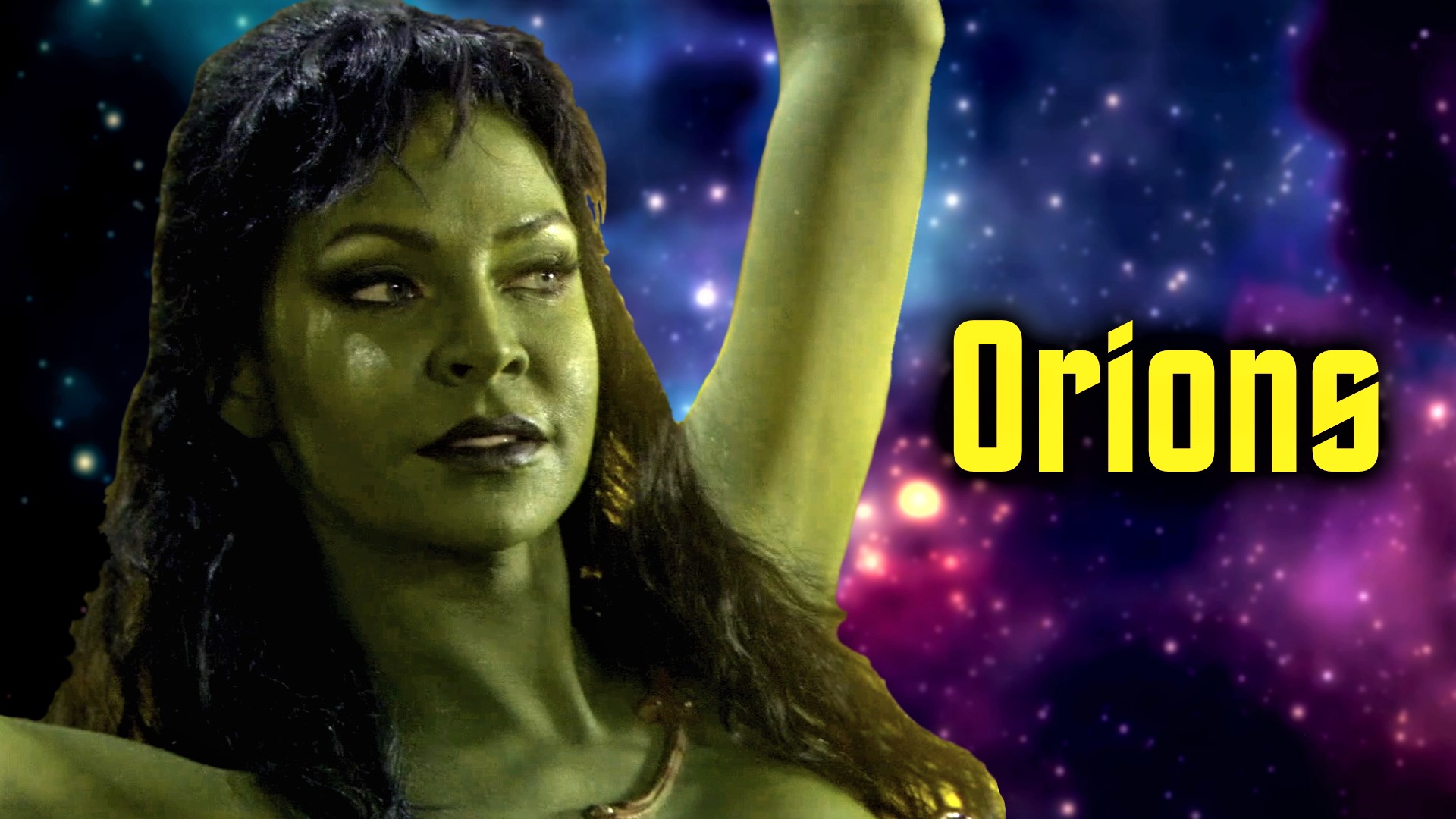Hey guys, what’s up? Tyler here. One of the most identifiable races from the Star Trek franchise, dating all the way back to The Original Series, is the Orion species. Characterized by their green complexion, their reputation for piracy, and their sensual nature, the Orions operate one of the most significant trading networks in the Alpha and Beta Quadrants. But today, beyond just their sociopolitical and economic affairs, I’d like to more deeply explore their biology and how it has influenced their position on the interstellar stage.
One of the most striking aspects of the Orions is, as mentioned earlier, their green skin. This has made them iconic in popular culture outside the show as an instantly recognizable element of The Original Series. Their first appearance in television was in the season 1 episode “The Menagerie,” which featured reused footage from the unaired pilot, “The Cage.” In the final draft of the script for “The Cage,” a line of dialogue that ultimately didn’t make it into the episode implied that green Orions are supposed to be rare. This is likely because Gene Roddenberry had originally conceived of the Orions as having more variation, but due to constraints, this never came to fruition.
Indeed, in various installments, we see Orions whose skin bears hues ranging from blue-green to yellow-green. They’ve also been known to possess hair color variations that include black, green, and red. Fun fact: when the green Orion makeup was first tested on Majel Barrett and Susan Oliver, the post-production lab sent back the footage three times with the actors’ skin tones adjusted to a normal color until Roddenberry finally had to tell them the Orions were supposed to be green.
In-universe, it’s interesting to consider what evolutionary conditions would have led to a sentient humanoid species developing such a deep green skin tone in the first place. Some non-canon sources suggest this is because Orion skin pigments are based on chlorophyll, much like plants on Earth which have chloroplasts. While this might initially seem like a silly idea, as other than green coloration there’s nothing else to tie Orions to Terran plant life, there’s actually some credence to this. As I explained in my video about the Asari from Mass Effect, the coloration of various extraterrestrial species is most likely explained by how they reflect different wavelengths of light around other stars.

In the case of the Orions, their star—Pi3 Orionis—is an F-type yellow-white star that is slightly hotter than our sun. Because they are hotter, F-type stars—which have slightly shorter lifespans—by definition emit more light in the bluer portions of the electromagnetic spectrum. Light of these wavelengths is more energetic, and thus, being closer to the UV portion of the spectrum, more harmful in high concentrations. It’s for this reason that life on planets orbiting F-types stars would need some kind of UV protection, like an ozone layer. In the absence of such shielding, DNA molecules planets such as these would suffer between 2.5 and 7.1 times more damage caused by UV light than on Earth.
The coloration of pigments in life found around F-type stars is subject to some debate, since of course we haven’t directly observed life on any planet except our own. But the knowledge we do have regarding solar radiation and the way various pigments absorb and reflect this radiation can give us some clues. As I just mentioned, F-type stars emit slightly more blue light than our sun, and according to astronomers, pigments found in life around these stars would behave in one of two ways. On the one hand, they could reflect this higher energy blue light and give off a bluer tint, or they could absorb only blue light and reflect lower energy wavelengths—namely, yellow, red, and, you guessed it, green. And of course, as we see on Orion, the plant life is in fact green. The sky even possesses a greenish tint, which is rather unexpected—it would still be blue or white around an F-class star—meaning there might be other gases in the atmosphere that affect the scattering of shorter wavelengths.
Anyway, just like other life forms on their planet, Orions may have skin pigments that are similar to chlorophyll. Additionally, non-canon sources describe historical populations of Orions with gray and red complexions as well, whose skin may have other pigments. This could jive with the concept of plant and animal life on a world orbiting an F-class star reflecting more than just one narrow color band in the visible spectrum. However, these alternate-colored Orions have not been featured in canon. Given that Orions’ blood is green, it might use the protein chlorocruorin or a copper-based variant of hemoglobin or even some combination of the two. Chlorocruorin is found in some types of marine worms but is actually bright green as opposed to the dark green blood possessed by Vulcans and Orions.
Regarding the age of their host star, whose real-world analogue is noted on a star map in Star Trek: Picard, Pi3 Orionis is only 1.4 billion years old according to best estimates. Now, you might ask, what does this have to do with anything? Well, if we are to believe that all humanoid life in the galaxy is genetically descended from a progenitor race as suggested in “The Chase,” then this presents two possibilities. Either the primordial genetic code of various species was transported via panspermia to certain planets younger than 4.5 billion years via some mechanism such as the Mycelial network, or Pi3 Orionis is not the Orions’ home system. In fact, both could be true and not be mutually exclusive.
The Orions are said to have once been a highly advanced civilization with a rich archaeological history; the dawn of their civilization was even witnessed by the USS Enterprise crew off-screen in the pilot episode of The Animated Series, “Yesteryear.” Non-canon sources suggest that their true origins have been wrapped up in mystery and marked by outside interference from other powers. They may have been slaves themselves at one point, continuing the institution after rebelling against their oppressors. This murkiness might be indicative that the Orions evolved on another planet in a different solar system and that Pi3 Orionis is merely their “current” homeworld, possibly dating back only a few thousand years.
Whatever the case, the Orions’ society, commonly recognized in conjunction with their slave trade, is largely influenced by yet another distinct biological characteristic: pheromones. Orion females are known to emit highly powerful pheromones that affect the physiology of other species. In heterosexual males of some species such as humans, these pheromones can trigger aggression and, after cumulative exposure, trigger delusions and suggestibility. Heterosexual human females are not shown to be affected by the pheromones and react negatively to them, and certain species with higher mental discipline such as Vulcans are effectively immune. Not all Orion females emit or utilize these pheromones, however, such as D’Vana Tendi.

These pheromones are, of course, commonly associated with Orion “slave women,” the concept being featured in episodes of Enterprise—but of course, as we learn, in the 22nd century, it is actually not the women who are the slaves, but the men. The women use their pheromones to wield power over their male counterparts. Some members of the Orion Syndicate also use the pheromones to influence the behavior of would-be slave masters of other species, with the true arrangement of gender roles in their society not being widely known for a long time. Orion women would perpetuate this deception by allowing themselves to be “sold” on slave markets while conducting covert operations for the Syndicate. It is possible this arrangement may have been reversed by the 23rd century, or perhaps the deception maintained, but by the late 24th century, slavery had been abolished in Orion society as we learn in Lower Decks.
Sexual dimorphism in Orions has also been more or less the norm when it comes to the Orions we see on screen—Enterprise was actually the first time we saw Orion males in live action. While females have traditionally been portrayed stereotypically in the form of slave girls, for example, in Enterprise, males were shown to be bald, muscular, and very tall. But Star Trek: Discovery has shown more variety not only in Orion skin color but also in the physical build of males—they’re not all gigantic dudes. Imagine that—variety of appearance in a humanoid species! Discovery also features Orions engaged in bisexual, polyamorous activity and introduces some other facts about Orion biology, such as their hearts having six valves and being able to pump blood in both directions.
Final Thoughts
The Orions are a really fascinating species to me particularly because of the fact that we don’t know as much about them as we do other species. Their history, as I mentioned, is clouded in mystery; their culture, while dominated by piracy in some of the older series, is given slightly more dimension in the newer installments; and their society and government being totally separate and independent from the Federation—this supposed utopia of the galaxy—is really interesting as well. I haven’t delved as deeply into Orion history and politics in this video as those have been covered in enough detail by other YouTubers—and of course, elements of their biology have as well—but I think the fact we’re seeing more of them these days is a great opportunity to expand on what has historically been a rather one-note race.
Thank you all so much for watching! I’m interested to hear your thoughts in the comments. If you haven’t yet subscribed, be sure to do that as well so you won’t miss future uploads and click the bell icon to receive all notifications. If you want to support my work even further, becoming a YouTube member or a patron at patreon.com/orangeriver is a great way to do so. I’ll see you in the next video…live long and prosper.
Watch Orange River Media’s Video
Thank you all so much for watching! I’m interested to hear your thoughts in the comments. If you haven’t yet subscribed, be sure to do that as well so you won’t miss future uploads and click the bell icon to receive all notifications. If you want to support my work even further, becoming a YouTube member or a patron at patreon.com/orangeriver is a great way to do so. I’ll see you in the next video… live long and prosper.
YouTube: https://www.youtube.com/orangeriver
Twitter: https://www.twitter.com/orangerivernw
Instagram: https://www.instagram.com/orangeriver.nw
Facebook: https://www.facebook.com/orangerivernw
Patreon: https://www.patreon.com/orangeriver












